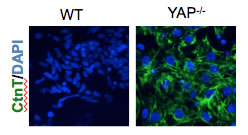Here’s a heartwarming story for the holidays. Scientists from the Salk Institute in La Jolla, California have figured out a simple, easy way to make beating heart cells from human stem cells that will aid research and therapy development for heart disease. Their study, which received funding support from CIRM, was published last week in the journal Genes & Development.
The Salk team discovered that making beating heart tissue from human stem cells is as simple as turning off a single gene called YAP. You might be wondering how the team settled on this gene and no, it doesn’t involve pulling a random gene name out of a hat.
In previous studies, the researchers found that two cell signaling pathways, Wnt and Activin, are crucial for the development of embryonic stem cells into specialized cells like cardiomyocytes (beating heart cells). This research led to the discovery of a third pathway, controlled by YAP, which sets up a road block for cell specialization and keeps stem cells in their undifferentiated state.

Only hESCs without YAP (right panel) make heart cells (green) in one step. Blue dye marks cell nuclei. (Salk Institute)
The team deleted YAP from these stem cells using CRISPR gene editing technology, and then treated the stem cells to the Activin signaling molecule. Without YAP, exposure to Activin prompted the stem cells to develop immediately into beating cardiomyocytes that you can see beating away in the Salk video below.
Dr. Kathy Jones, Salk professor and senior author on the study, explained why this discovery is important to the field in a news release:
“This discovery is really exciting because it means we can potentially create a reliable protocol for taking normal cells and moving them very efficiently from stem cells to heart cells. Researchers and commercial companies want to easily generate cardiomyocytes to study their capacity for repair in heart attacks and disease—this brings us one step closer to being able to do that.”
First author, Conchi Estarás, emphasized how their new method for making cardiomyocytes is attractive not only for its simplicity, but also for its cost-effectiveness in enabling large-scale manufacturing of these cells for treatment.
“Instead of requiring two steps to achieve specialization, removing YAP cut it to just one step. That would mean a huge savings for industry in terms of reagent materials and expense.”
Looking ahead, Jones and her team do not plan on deleting the YAP gene from stem cells because of the potential side effects cause by the loss of YAP’s other cellular functions. Instead, they will be using commercially available molecules that can temporarily inhibit the function of YAP in hopes that this less permanent action will still readily produce beating heart cells from stem cells.

Kathy Jones and Conchi Estarás. (Image courtesy of Salk Institute)
Hi
Thank you for an excellent insight into the possibility of regenerating heart beating cells. This is clearly a major breakthrough which would help save millions of lives across the world.. I’d be very interested in understanding more about the study and timescales for trials and widespread use.. I have a personal interest as my father suffers from heart failure..
Many Thanks
Shiraj Vali
United Kingdom
+44 7904 817 824
Thanks for the comment Shiraj. Here’s a link to the study; http://genesdev.cshlp.org/content/early/2017/12/21/gad.307512.117.abstract That’s probably the best place to start and learn about timelines, and then I think contacting the researchers would be a good second move.
Kevin